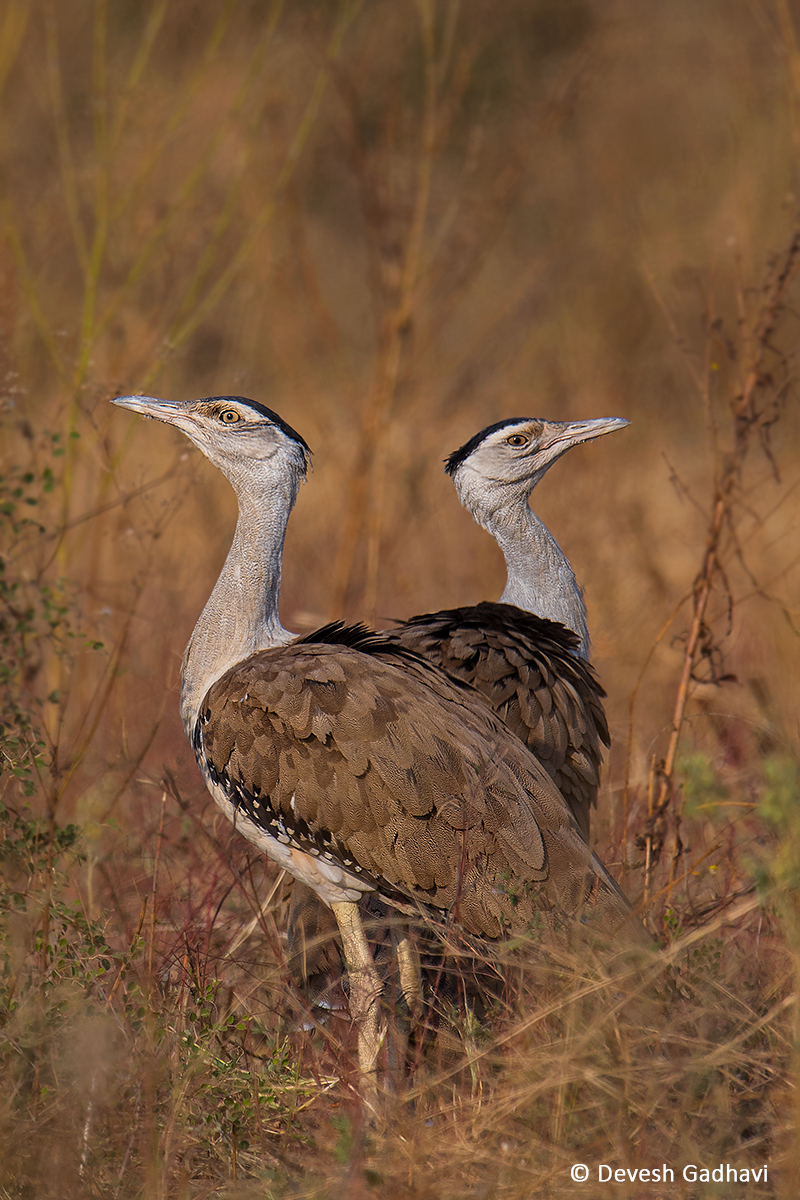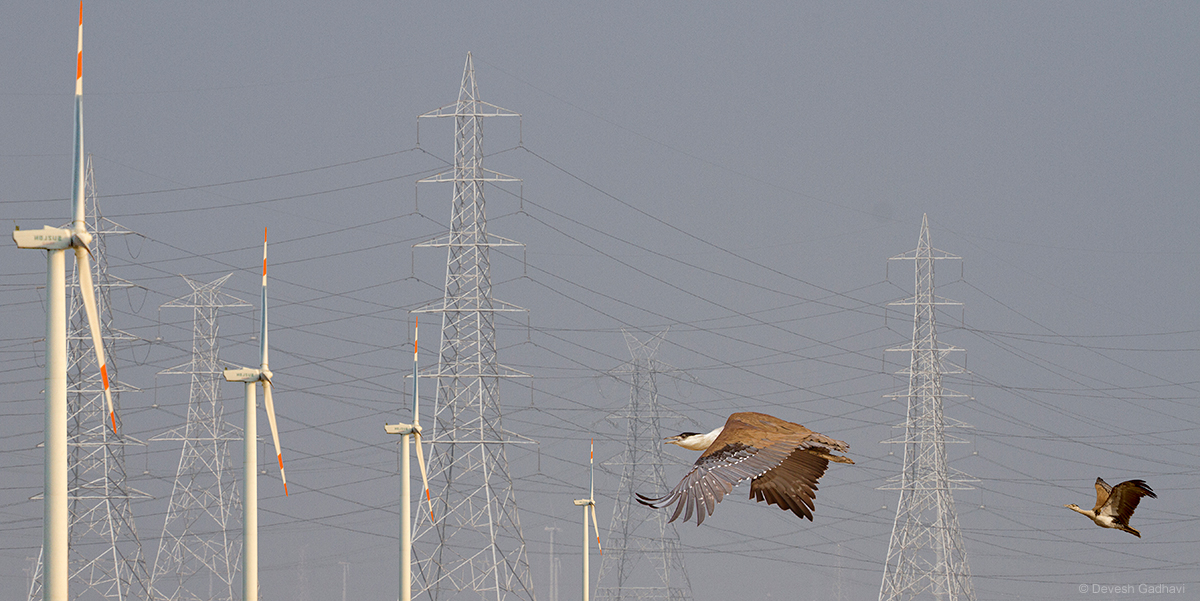The Great Indian Bustard is a critically endangered bird with its last viable breeding population in India. Though habitat loss and degradation have been responsible for this bird’s decline in the past few decades, their deaths due to collision with overhead power lines are today the biggest direct threat. The Bombay Natural History Society and The Corbett Foundation hailed the Supreme Court judgment that directed that powerlines had to be taken underground in the Great Indian Bustard habitat, says ANAND SINGHA.
—-
TODAY, only about 100 of the Great Indian Bustard (GIB) remain in the world. It needs grasslands and semi-arid areas to survive. Most of these areas are unfortunately categorised as ‘revenue wastelands’ in governmental records, and therefore given away for solar and wind energy projects in India.
Large renewable energy projects across GIB habitats, mainly in Rajasthan and Gujarat, have put these already threatened species at grave risk of extinction.
The Wildlife Institute of India (WII) estimates that 18 of the Great Indian Bustards die each year due to collision with power lines, making power lines the most significant threat.
SC’s direction in M. K. Ranjitsinh vs Union of India: priority should be given to the near-extinct birds
In light of the conservation needs of this critically endangered species, the Supreme Court’s direction in M. K. Ranjitsinh vs Union of India (W.P 838 of 2019), dated 19th April 2021, is significant as it gives specific binding directions that have to be mandatorily followed in GIB habitats. It makes it mandatory for all powerlines in both the ‘potential’ and ‘priority habitat of the GIB to be laid underground in the future.
The Court has directed that powerlines be taken underground immediately, stressing that irrespective of the cost factor the priority shall be to save the near-extinct birds. Until the lines are made underground, bird-diverters are to be installed on all lines immediately.
Only for those high voltage powerlines where technical feasibility issues are found in undergrounding, the SC has constituted a three-member expert committee to examine the feasibility.
Significantly, the Court has also given specific direction to protect the nesting sites of the GIB.
For the undergrounding of powerlines, the Supreme Court has given a time limit of one year from the date of the order within which the undergrounding is supposed to be completed.
It is important to note that renewable energy units already existing in the area have not been asked to move from sites or stop work in Rajasthan or Gujarat. Instead, they have been asked to take their lines underground and, till then, install bird diverters.
Disobedience and Contempt of court?
Kedar Gore, the Director of The Corbett Foundation says, “Despite the SC order, the work on laying of overhead power lines is continuing in Rajasthan and Gujarat without complying to the conditions laid down by the Supreme Court. None of the existing power lines has been fitted with bird diverters. This disobedience amounts to contempt of court. New renewable energy parks have been planned in Gujarat, Rajasthan, Maharashtra, and other states. We hope that the companies involved have taken appropriate measures in their planning stages to create infrastructure as mandated by the SC order on the power lines in GIB habitat.”
These are important steps to conserve and prevent the extinction of a bird that is named after India and was once spread all over West India and the Deccan plateau.
Today, the GIB’s regular breeding sites are only in the Thar desert landscape (Rajasthan) and Kutch landscape. Despite having good habitat, the bird is locally extinct in Madhya Pradesh. A few birds are found in Pakistan, moving between the two countries.
India’s plan of action:
For this reason, India recently proposed a Concerted Action Plan for the GIB under the aegis of the Convention on the Conservation of Migratory Species of Wild Animals (CMS). This was approved by the CMS [decision UNEP/CMS/Concerted Action 13.10] in the last CMS Conference of Parties meeting, held in Gujarat in February 2020. Even in this plan, emphasis has been given to minimise the collision by relocating, realigning, or redesigning the infrastructures of power lines, windmills, and solar panels and bringing the renewable energy projects under the umbrella of strict environmental impact assessment (EIA).
India is the current President of the CMS. To fulfill its commitments towards the GIB, India has pioneered a Conservation Breeding Program in Rajasthan.


This has been successfully implemented by the Wildlife Institute of India (WII) in collaboration with Rajasthan Forest Department, and several chicks are currently being raised at this centre.
These chicks eventually have to be released in GIB habitat not only in Rajasthan but in all its former range. But for this to happen, large swathes of safe and secured habitats must be made available to GIB in the future.
Dr. Bivash Pandav the Director of the Bombay Natural History Society says, “One of the most charismatic bird species of India, the Great Indian Bustard, is undoubtedly standing at the doorstep of extinction. With a population of less than 100, the Thar desert is the only Intensive Critical Care Unit of Great Indian Bustard in the world. BNHS applauds the judgment of Hon. Supreme Court of India and firmly believes in leaving no stone unturned in safeguarding the remaining Bustard habitats in the Thar desert.,”
Importance for other Bustard Species – Lesser Floricans
GIB habitat areas are also important for endangered birds like the Lesser Florican and MacQueen’s Bustard, which are smaller Bustard species requiring grasslands to survive. It is also pertinent to point out that several other birds also die on collision with powerlines. The WII also estimates that over 1 lakh birds are killed annually in Thar by electric lines. TCF’s unpublished data reveals that nearly 30,000 birds of different species die due to collision with power lines annually just in Abdasa taluka of Kutch District Gujarat.
The GIB habitat in Abdasa also provides refuge to about 25 other globally threatened birds. Several lesser-known but threatened species of mammals such as caracal, desert fox, desert cat, hedgehog, hyena, Indian wolf, etc.
The Bombay Natural History Society and The Corbett Foundation have been working for the conservation of Bustrards for decades, including monitoring, habitat improvement, community engagement, and conservation planning with state forest departments and villagers. They have been maintaining that India can only fulfill its green goals by working together to ensure the last of these birds should survive and flourish in the wild.
By preserving the last arid and grassland landscapes for present birds and future birds to be released from captivity, India can take a leadership role in the conservation of Bustards. India will also do well to formulate a Grassland Conservation Policy that protects the interest of species dependent on these important ecosystems and also of the local communities with whom the GIBs coexist in agro-pastoral landscapes.
(Anand Singha is a student at the Symbiosis Institute of Media and Communication and is an intern with The Leaflet.)


